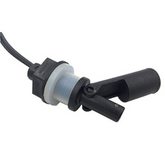What is a Magnetic Float Sensor?
Summary
Do you want to Discover the Power of Magnetic Float Sensors? This blog post covers their working principle, benefits and why you need a float switch for effective fluid level management. Magnetic float sensors provide accurate and reliable measurements and play a critical role in various industrial and commercial applications. Get ahead of the game and optimize your fluid level management today!
Magnetic Float Sensors are sensors which are used to detect the level of liquid within any kind of container. Magnetic float sensors feature a magnetic float that rises and falls with the level of liquid.

Magnetic Float Sensor FSH01 (Horizontal)
A magnetic field is created due to the movement of the magnetic float which actuates a hermetically sealed reed switch. It is located at the level sensor's stem and triggers the switch's opening and closing. These sensors can cost anywhere between Rs. 100 to Rs. 10,000 based on their various additional features.

Magnetic Float Sensor FS37A (Vertical)
What is the Use of a Magnetic Float Sensor?
The major application of a magnetic float sensor is in tanks, sumps and pumps.
It is used as a level alarm or indicator and in pumps because it is a highly reliable liquid level detection system, preventing costly or dangerous overflows and low storage levels depending on the application.
Naturally, magnetic float switches are available in a range of options and configurations to suit a wide range of application demands. Variations of the magnetic float sensors are used in different industries such as chemical, petrochemical industry, natural gas, offshore, shipbuilding, machine building, power generating equipment and power plants. They are used in various mediums other than water, such as oil, chemicals, petroleum and other liquids.
When a permanent magnetic float level switch and reed contact switching the operation is non-contact, wear-free and needs no power supply. A magnetic float’s functions are completely independent of variations, bubble formations, foaming, conductivity and harmful vapors.
Why do you need a float switch?
The function of a float switch is to open or close a circuit as the level of the liquid rises or falls. The operation of the float switch is based on the basic principle of buoyancy principle which states that “the buoyancy force acting on an object is equal to the mass of liquid displaced by the object”. This means that the float stays partially submerged and moves the same distance as the liquid does. Due to this, the sensors are usually used for narrow-level differential applications such as high-level or low-level alarms.

Application of float sensor in reserve tank
To complete the circuit, the float switch utilizes the magnetic reed switch. It consists of two contacts that are sealed in a glass tube. As a magnet gets close to the two contacts, the contacts are attracted to each other and touch. This allows the current to flow through the. As the magnet moves away they demagnetize and separate, breaking the circuit.
Working Principle of a Magnetic Float Sensor

Different parts of the sensor
The magnetic float sensor is partially submerged in the liquid, tracking the liquid surface motion precisely. As the liquid level rises the float gets lifted, which slides the attraction sleeve up inside the enclosing tube and into the magnetic field to actuate the electrical or pneumatic switch. This signals the presence of the liquid.

How Magnetic float sensor works
Similarly, as the liquid level decreases the float gets lowered, which draws the sleeve out of the magnetic field and deactivates the electrical or pneumatic switch. This indicates the absence of the liquid.
As the working principle of the magnetic float sensor relies on the interaction between magnets, this device doesn’t require a power source. They are also almost maintenance free and their magnetic force can affect optional switches or transmitters mounted outside of the chamber.
Conclusion
In this blog post, we have learnt that magnetic float sensors are a crucial component in various applications, serving as a reliable and efficient way to monitor fluid levels, a magnetic float sensor can provide accurate and cost-effective solutions. With its simple working principle and ease of use, having a float switch is an intelligent choice for anyone looking to enhance the functionality of their system. Don't miss out on the benefits a magnetic float sensor can offer - upgrade your system today!
If you appreciate our work don't forget to share this post and leave your opinion in the comment box.
Please do check out other blog posts about Popular electronics
Make sure you check out our wide range of products and collections (we offer some exciting deals!)






